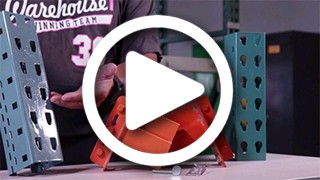Pallet Weight Limits and Capacities
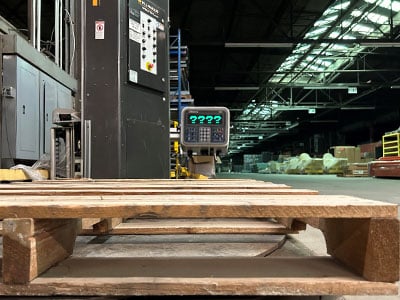 You've put a lot of thought into the layout and workflow for your warehouse or distribution center, emphasizing a curated design that will accommodate the unique needs of clients, customers, vendors, and employees.
You've put a lot of thought into the layout and workflow for your warehouse or distribution center, emphasizing a curated design that will accommodate the unique needs of clients, customers, vendors, and employees.
All this can spell huge improvements, but it will mean little if you've neglected to take care of the basics, such as pallet weight limits and capacities. These are far more nuanced than you may initially think, with everything from pallet material to item sizes and even racking coming into play. While you may know the standard GMA minimum pallet weight limit is 2,500 lbs., it's important to understand when these capacities apply.
An in-depth understanding of palletizing is essential. To that end, we've provided important details on the integral role that pallet construction and capacity play in modern warehousing, plus considerations regarding pallet materials and size — and even racking structure. Keep reading to learn what pallet weight capacities mean and how they might play into your pallet racking strategy.
Understanding Pallet Weight Capacities
Before we get into specifics, let's touch on how pallets work. These rigid, yet highly portable platforms are designed to move a variety of products in the most reliable and efficient manner possible. They can be placed on pallet racks, which often form the basis of warehouse layouts. From there, pallets can easily be transported around the warehouse environment via forklift or pallet jack.
In general, pallets are designed to accommodate sizable loads. They are sturdy enough to protect items as they move about the warehouse and navigate the supply chain. Still, they can vary dramatically in terms of capacity. Factors worth noting include:
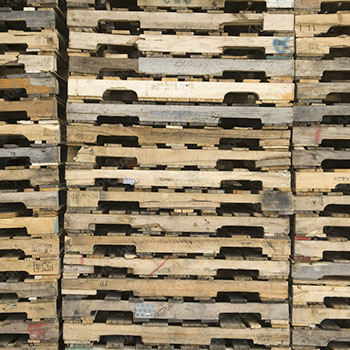 Material. Wooden, plastic, metal, and paper pallets have different capacities and levels of durability. Their costs can vary to a surprising extent. We will delve more into these considerations below.
Material. Wooden, plastic, metal, and paper pallets have different capacities and levels of durability. Their costs can vary to a surprising extent. We will delve more into these considerations below.- Condition. It should come as no surprise that new, well-built pallets will be able to accommodate higher volumes than older products that have been exposed to significant wear and tear through the years. Even the best pallets are bound to eventually degrade and may no longer accommodate larger loads. The condition of the pallet racking system must also be considered.
- Load distribution. Ideally, load weights should be evenly distributed across multiple pallet racking beams. The gold standard involves uniformly distributed loads (UDL), as uneven loads reduce the overall weight capacity. When uneven loads are necessary, extra support can be provided via wire decking. Strategic stacking is also crucial; this means knowing when to use columnar versus interlocking setups.
- Pallet rack quality. Well-built pallets must be supported by sturdy pallet racks. These, like the pallets themselves, can vary significantly in terms of durability. Capacities for both pallets and racks must be compared and contrasted before investing in either.
Different Types of Pallets and Their Weight Limits and Capacities
While pallets are incredibly versatile, they tend to occupy a few main categories. These are often designated based on the materials used to construct the pallets, although pallet size can also prove influential. Top options include:
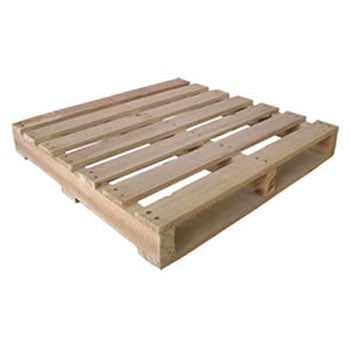 Wooden Pallets
Wooden Pallets
Wood pallets have traditionally been the most popular, to the point that this is almost certainly what comes to mind when you picture a standard pallet. Their notoriously low cost makes them compelling for a variety of warehousing operations.
Common types of wood include pine and oak. This category can be further divided into subcategories such as stringer pallets or block pallets. Chief downsides include susceptibility to moisture and pests.
Capacities can vary wildly for wooden pallets, but loads of around 2,500 pounds are typical for stringer pallets, while block pallets may accommodate up to 5,500 pounds for static loads.
GMA Pallets
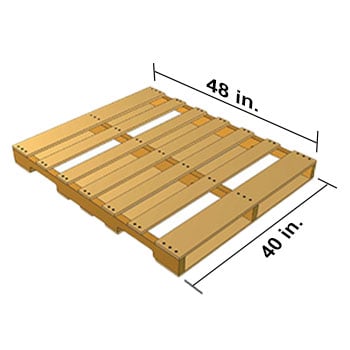 The Grocery Manufacturers Association (GMA) designated a standard pallet size and build. Known as GMA pallets, these involve seven top and five bottom deck boards. These pallets have dimensions of 48″ deep x 40″ wide and should accommodate at least 2,500 pounds.
The Grocery Manufacturers Association (GMA) designated a standard pallet size and build. Known as GMA pallets, these involve seven top and five bottom deck boards. These pallets have dimensions of 48″ deep x 40″ wide and should accommodate at least 2,500 pounds.
GMA Standards
- 48” deep x 40” wide.
- Load capacity of at least 2,500 pounds.
- 4-way forklift entry with two notches on the 48” side of the pallet.
- Base and top deck boards must be 5/8" thick.
- The pallet top must have two board ends (one on each end) measuring 5 1/2" x 40”, and in its center should be five boards measuring 3 1/2" x 40”.
- The pallet bottom must have two board ends (one on each end) measuring 5 1/2" x 40”, and between the notches should be three boards measuring 3 1/2" x 40”.
GMA Pallet Grades
Grades correspond to the pallet's condition. The grading system is as follows:
- Premium Grade: Pallets in this category are in excellent condition, showing minimal signs of use, and require no repairs.
- Grade A or #1: Pallets in Grade A or #1 are in good condition. They have typically seen limited use and have been restored as needed. Repairs may include replacing broken stringers or damaged deck boards.
- Grade B or #2: Grade B or #2 pallets have undergone repairs to their stringers, commonly done by adding an additional companion, double, or block stringer next to the damaged one. In most cases, a grade B pallet will have a maximum of two restored stringers.
- Grade C or #3: Grade C or #3 pallets are generally in poor condition and are not widely accepted by most companies. These pallets have undergone multiple repairs and exhibit inconsistent deck boards and multiple companion stringers.
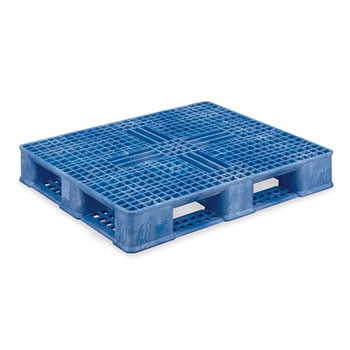 Plastic Pallets
Plastic Pallets
Consistency represents the greatest advantage of plastic over wood. Plastic pallets are precisely engineered, so you can feel more confident that their stated capacity will actually prove accurate over time. Typically, dynamic loads top out at 5,000 pounds, but static capacities have been known to exceed 10,000 pounds.
Another benefit: plastic pallets are resistant to moisture and microbes, which are often top issues for their wooden counterparts. Unfortunately, these pallets can easily become deformed when dealing with heavy loads. They are also more expensive than wooden pallets, although these upfront costs may be offset by long-term savings from higher capacities and more accurate calculations.
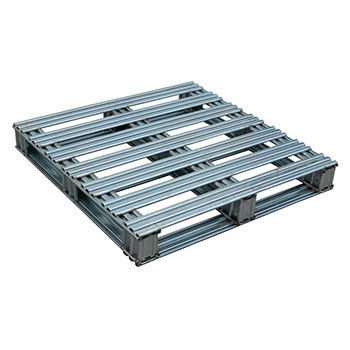 Metal Pallets
Metal Pallets
Capable of handling extremely heavy loads, metal pallets provide a variety of unique benefits that make them a worthy alternative to common counterparts such as wood or plastic. These durable pallets are clearly built to withstand transit. What's more, they are pest-free and easy to clean. Eco-friendly enterprises favor these pallets because they are easy to reuse and recycle.
The major downside, of course, centers around the high upfront cost. Their significant weight can also be problematic in some situations, especially if racking systems are unable to accommodate heavier pallets. Dynamic capacities often reach 4,000 pounds, with double this possible for some static loads.
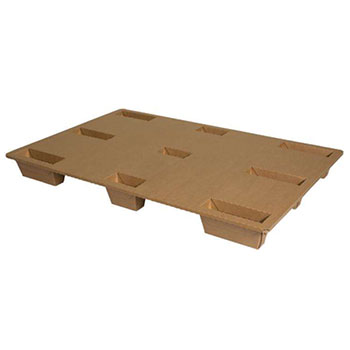 Paper Pallets
Paper Pallets
As an increasingly popular alternative to wooden pallets, paper solutions are highly sustainable, and therefore, a wonderful option for green businesses that cannot handle the cost of metal pallets. Paper pallets might not be the most durable on this list, but they are stronger than many skeptics realize. They gain greater durability from their often corrugated design.
Paper pallets share similar downsides with their more common wooden counterparts, including susceptibility to moisture. Their capacities often resemble those of wood pallets, with around 2,000 pounds as a realistic for dynamic loads.
Pallet Design System
These days, many of the standard pallet capacities we take for granted are shaped by the Pallet Design System. Made possible by the National Wooden Pallet & Container Association (NWPCA), this analysis tool provides valuable insight into pallet types, sizes, and styles, including details about the many types of wood, nails, and staples available.
How to Choose the Right Pallet for Your Warehouse
With so many options available, it can be difficult to know where to begin when ordering new pallets. Load ratings can be a helpful starting point, as these reflect different weight concerns and contexts. These occupy two main categories: static and dynamic load capacity.
Simply put, static loads aren't expected to move — but movement is built into the very concept of dynamic loads. As such, the static load capacity references how much a pallet can handle when it's at rest or in storage, while dynamic involves the weight capacity for a pallet that's being moved by a forklift or is otherwise in motion. Static load capacity is typically far higher for most pallets.
Beware Non-rackable Pallets and Skids
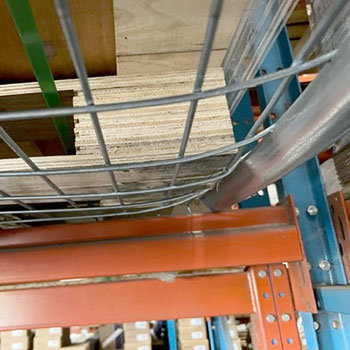 An increasing number of plywood import pallets, cube pallets, skids, and plastic pallets that do not meet GMA standards are infiltrating warehouses and resulting in pallet rack failures. The common issue with these pallets is their inability to properly distribute the weight of the contents to both beams on the pallet rack storage level.
An increasing number of plywood import pallets, cube pallets, skids, and plastic pallets that do not meet GMA standards are infiltrating warehouses and resulting in pallet rack failures. The common issue with these pallets is their inability to properly distribute the weight of the contents to both beams on the pallet rack storage level.
When these pallets are placed in the rack, all or part of their weight falls on the wire decking or pallet supports below, resulting in potential bowing of the pallet, wire deck, and/or pallet supports. To mitigate the risk of rack failure and collapse, use standard pallets that adequately rest on both the front and back beams.
Understanding Pallet Rack Weight Limit
Pallet selection begins with understanding the realities of your current pallet racking setup. What are the weight limits on these racking systems? Rack capacity depends largely on the type of steel used, with both the gauge and grade of that steel warranting consideration. Load distribution and vertical beam spacing also matter. Be prepared to carefully weigh the trade-off between high-density storage and flexibility or ease of turnover.
The Risks of Overloading Pallets
No matter which types of pallets you prefer, it is crucial that you avoid overloading them. Excessive weight is a key risk factor for collapse, which could prove devastating from a safety perspective. Even if you're able to avoid such catastrophes, overloaded pallets are more likely to degrade or, if constructed from plastic, warp.
Your pallet racks could also be at risk, as it can be difficult to determine how much they're actually supporting when your pallets are overloaded. The costs of replacing or repairing pallets or racks can add up quickly, as can the cost of replacing damaged items or materials.
Optimize Your Pallets and Pallet Racking System
Given the individualized nature of pallet racking systems, you need expert insight to help you determine how different pallets and sizes might fit into your warehouse setup. Our team at Warehouse1 can point you in the right direction. We offer not only helpful advice but also a variety of well-built pallet racks that accommodate many types of pallets. Reach out today to learn more.



